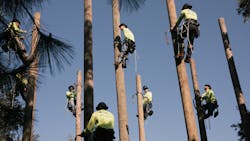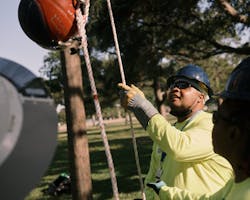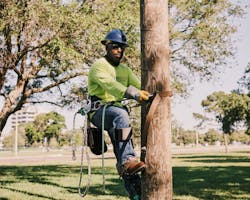Over his last 38 years in the utility industry, Barry Anderson, Duke Energy’s regional senior vice president of customer delivery in Florida, has noticed a lack of diversity in the line trade.
“I think it has been a missed opportunity for utilities,” he said. “In the St. Petersburg’s Operations Center for example, the linemen didn’t represent the diversity of the community, and I don’t think we were alone. Throughout the United States, we need to find ways to educate communities that these jobs are out there.”
The key to increasing diversity in the line trade is to first diversify the candidate pool for hiring apprentices and next to think local. “I‘ve witnessed across the country a gap in diversity within the lineman craft,” Anderson said. “And believe industry wide, it starts with the interviewing and hiring process and an element of unconscious bias. This program works around that.”
Instead of simply marketing opportunities about line trade to high school students, electric utilities and line contractors must dive deeper to make a difference, Anderson said. For example, Duke Energy joined forces with a local contractor and community partners to launch a new certification program at St. Petersburg College. The 14-week program empowers people from different backgrounds, cultures and ethnicities to discover the life-changing career of line work. The utility invested $100,000 into the facility, classroom materials and instructor and $30,000 for the equipment at St. Petersburg College to expose the students to line work.
“I can imagine over the next five to 10 years that there will be a pipeline of students, and this will be a great career for them,” Anderson said. “I think this is just starting to catch on in our industry.”
For the program at St. Petersburg College, 30% of the students are white, and the other 70% are people of color. One student in the first class was female. In many cases, the students may have never been exposed to line work, and they don’t have any family members in the trade. “In the past, a lot of the prescreening and testing positioning the top candidates requires them to have some background in the trade,” he said. “For example, they may have a family member who was a line worker. That puts the minorities at a disadvantage. We are trying to break the wall down, expose them to the craft and give them the sense of what it takes to do the work.”
Learning the Trade
Line work can be physically demanding, and as such, many of the students in the first class of the training program were former high school athletes with the physical stamina and discipline to succeed in the line trade.
“They have the ability to follow rules, can think adaptively and have the physical skills and energy to get the work done,” Anderson said. “Plenty of high schools have kids with this raw talent for line work. The idea is to set a path for them and encourage them to see the benefits.”
Once the students don their hard hats, slip on their boots and latch on their fall protection devices and start climbing poles, not all of them make it to the end—but that’s OK, Anderson said. “The reality is that not everyone likes the introduction to line work. You have to have a mindset. In the program, we teach them how to be a line worker. They don’t have to come in and know a lot about the type of work that is done.”
The program has the capacity for four classes a year, each with 14 students. The second class had a waiting list of 1,000 people.
“I am extremely pleased with the program,” Anderson said. “The ones who have come through all had offers to be hired.”
Anderson has encouraged its supervisors and line workers to visit the college to mentor the students whenever possible. The college is located only three miles away from the nearest Duke Energy service center, making it easy and convenient for the Duke Energy line workers to lend a helping hand.
“I would like to hire as many of the students as I can for Duke Energy, and we need to build that bridge,” Anderson said. “We need to mentor from an industry perspective about the craft and connect with them if they have questions. The mentorship is important when learning a physically challenging job.”
One reason why Duke Energy decided to invest in a program in its own backyard is that it has found that students like to stay in town after they finish training.
“They can go on a plane and go thousands of miles from where they grew up to do training, but will they stay in the location they land their first line worker position?” Anderson asked. “Eventually, they will want to go back home. That’s why we looked to do the program more in our service territory and there is a push to do it local to the community as possible.”
Training the Future Line Worker
When launching a new program, it takes the commitment from a lot of different stakeholders, Anderson says. Case in point: Duke Energy partnered with PowerTown Line Constructors, a local line contractor, which works with Duke Energy and other utilities like Tampa Electric Co. (TECO).
Steve Magenheimer, training director at PowerTown Line Construction, worked at Duke Energy for 35 years before retiring in 2017. His best friend, Steve Townsend, owned the line contracting business.
“He had the vision of starting a school, and he invited me to come to PowerTown and figure out how to make it happen,” he said.
So far, he has trained one class and is gearing up to start the next class in November. Out of the first class, five got jobs with Duke Energy, five hired on with PowerTown Line Construction, and one went to Spectrum.
“The most gratifying moment is when they land a job, and I know that they will make $75,000 in their first year, and after four or five years, they will make six figures,” he said. “Many of them have never had a structured career up to that point, and they never had any benefits like health insurance or paid time off. That is life changing for them.”
Magenheimer loves giving back to the line trade in his role as the instructor at St. Petersburg College. “The students are a sponge and absorb everything,” Magenheimer says. “It’s rewarding to see them grow and be successful in the end.”
Before each class starts, he meets with representatives from Duke Energy, Pinellas Urban League and the college to narrow down the applications from 1,000 or more to about 25 possible candidates. Next, they organize a video interview with each applicant and select the final group of students, who are invited to the college to start the program. When they first come on board, he says that they are “pretty green,” Magenheimer said.
“They know nothing about climbing or using a Buck Squeeze or fall restraint,” he said. “They have never put hooks on in their lives or been high up on a platform. The first few weeks are a bit sketchy.”
To make them feel more comfortable, he teaches the students the fundamentals of the climbing gear and how it works. The students learn how to take the belt apart and then put it back together. “I take them to the point where they can do it with their eyes closed, and they know it like the back of their hand,” he said.
During the second week, he gets the students on hooks and starts them off low — at about 5 feet off the ground — with ropes strung across the pole with big plastic clothespins. He instructs them to lean out and touch the pole. After they reach this milestone, the students scale the poles 10 ft off the ground and toss a ball back and forth.
“By the end of the day, they are trying to let their fears go by the wayside,” he said. “Some of them don’t trust their hooks and think they will fall. I work with them one-on-one to get over that fear. It can cause a lot of anxiety, so I try to keep them calm and have them think about something other than climbing. Sometimes it works, and sometimes it doesn’t.”
Not all the students in the training program ultimately need to become line workers. “It’s not cut out for everyone,” he said. “You almost have to be a little crazy to do this kind of work.”
For those students who aren’t comfortable with climbing the poles, Magenheimer tries to discover other opportunities for them outside of line work. For example, after calling around to his contacts, he got one of his past students a lucrative job at a power plant in Augusta, Georgia. When they join Power Town, they also have the option of working on overhead or underground power systems.
“I watch them closely over the 14 weeks to see where they might fit. If they don’t like to climb, I try to get them another kind of job.”
Even after the students graduate from the program, he keeps in touch with them and serves as a mentor. For example, he created a group text to keep in touch with his former students. “They know they can always call me, and I will be a mentor,” he said. “I have kids that call me from years ago, and if they get into a bind and can’t figure something out, I have the answers for them. With the St. Pete group, we talk all the time.”
In the future, he sees the program continuing to grow and evolve. “This is just in the beginning stages,” he said. “I have visions of building something for the college that is a four-year program where they can come out of high school, train for four years and then leave as a lineman.”
To offer more flexibility for the students, he would also like to have two trainers training during the day and two at night. “All the students who came to my class had to quit their job or work on nights and weekends to support their families,” he said. “It’s not easy for them.”
If given the chance, anyone can succeed in the line trade, and he is proud to be a part of the program. “We need to make the opportunity available to everyone, and this school is a good way to make that happen,” he said. “By diversifying the pool, we can give them the chance to succeed.”
Sponsoring Candidates
To cover the $5,000 cost of the program, the students can apply for two different grant programs including one through the Pinellas Urban League and another from CareerSource Pinellas.
“We screened them to see not only who resided in the community, but also who had the most need for it,” said Calvin Brown, workforce development specialist at the Pinellas County Urban League in St. Petersburg, Florida. “We did a rigorous selection and vetted those who were serious about the opportunity and willing to work hard. Five grand is a hefty ticket for the program, so we are glad we are able to sponsor these individuals and keep them going.”
Partnering with the two community organizations was critical to the success of the initiative, Anderson said.
“They know where the right leads are and maybe where we can go in the future to attract students,” Anderson said.
Brown agreed. “With us being a community organization, we can go into spaces Duke may not be able to go into and be able to convey the message in a language they understand,” Brown said.
The electric utility may have been powering St. Petersburg for more than 100 years, but the local high school students, especially minorities, may not think they have an opportunity to get hired.
“You may not even apply if your uncle or cousin applied for a job and was turned down,” he said. “That’s why it’s so important for utilities to take the ‘go local’ approach and work with stakeholders to get a better impression of a utility. We don’t want high school students to get discouraged and not take a chance. Every lineman and supervisor at the service center was young once and was given the opportunity to work at Duke Energy.”
Brown said the program dates back to 2015, when Duke Energy approached the Urban League. The utility was looking for ways to diversify the workforce and hire workers who better represented the community they served. His wife took the project on and organized information sessions in the communities.
“We had rooms full of individuals who were interested,” Brown said. “What made the information sessions so popular is that we brought in linemen and executives from Duke Energy to talk about what to expect from the process and how to get through an interview.”
One of the participants, who ended up completing the first class of the certification program, worked at a hotel as a night clerk before entering the line trade. “Before we did the informational sessions, he didn’t know about the great opportunity to become a lineman,” Brown said. “He went from making minimum wage as a night clerk to being able to make more than he ever did before, support his family and buy a house in the first year.”
Brown commended Duke Energy’s efforts to diversify its workforce. He said the program has received a positive response in the community, and the City of St. Petersburg wants to get more involved.
While the program at the college teaches them skills in the line trade, the Pinellas County Urban League focuses on preparing the candidates through professional development. “We make sure that they are ready for interviews and prepared once they get on the job to be on time,” Brown said. “We pour a lot into the students to make sure they are successful. The class makes sure they are ready physically, and we make sure they are ready mentally.”
The certification program gives the students a leg up on the job interviews by making them feel more comfortable. Even so, the participants need to be able to complete the coursework and handle the physical tasks. Magenheimer, the instructor, however, takes a hands-on approach.
“I see them climbing a pole in 90°, and I know I couldn’t do that,” Brown said. “It is hard work, but they work hard, and I commend them. They may have had dads or uncles who worked construction, and they want to learn these kinds of things. Once they complete the program, they have an open door to walk through to change their lives.”
In the future, he sees the participation growing stronger and stronger. Duke Energy, Power Town Line Construction and the community organizations spent a year-and-a-half through the pandemic to get the program up and running and funded.
“I look forward to continuing the work we are doing and help individuals find great opportunities of being a lineman,” Brown said.
As Anderson looks ahead, he sees the students filling the work boots of the growing number of linemen who plan to retire in St. Petersburg and Orlando, Florida. He says seeing the pole yard at St. Petersburg College up and running was a memorable moment. Duke Energy’s linemen helped to install 30 poles with different wire sizes and connections.
“Frankly, I am still shocked,” he said. “Someone in my position knows that all initiatives you set out to accomplish either take longer than expected or never get off the ground. I feel honored to be a part of it knowing what it will do for the community for years to come. To me, it’s a win-win.”
Ten years from now, he will be long since retired, but he says he is excited to see the progression of the apprentices who will one day become journeymen line workers at Duke Energy.
“I will thank our first graduates in St. Pete for getting the word out and for how much the program has taken shape,” he said. “To be a part of this program and know that you left something that is sustainable over time makes you feel great.”
Once an aspiring line worker completes the proper training, the line trade can provide a career for life, he said.
“It is very engaging work that pays well,” Anderson said. “You can create a good standard of living for you and your family, and at the same time, it gives you the intrinsic value of helping families, customers and communities. If you have the physical capability to do the work and not be afraid of heights or electricity, you can get on the path to a true career. Our linemen work in some of the most tough environments — the rain and in the middle of the night. It becomes part of who you are. When you are a lineman, you are part of a proud industry.”
Amy Fischbach is the Field Editor for T&D World magazine.
About the Author
Amy Fischbach
Electric Utilities Operations
Amy Fischbach is the Field Editor for T&D World magazine and manages the Electric Utility Operations section. She is the host of the Line Life Podcast, which celebrates the grit, courage and inspirational teamwork of the line trade. She also works on the annual Lineworker Supplement and the Vegetation Management Supplement as well as the Lineman Life and Lineman's Rodeo News enewsletters. Amy also covers events such as the Trees & Utilities conference and the International Lineman's Rodeo. She is the past president of the ASBPE Educational Foundation and ASBPE and earned her bachelor's and master's degrees in journalism from Kansas State University. She can be reached at [email protected].





